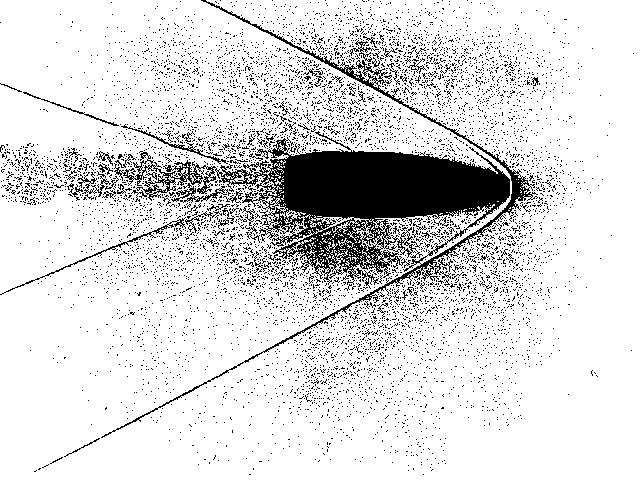
EVERYTHING YOU ALWAYS WANTED TO KNOW ABOUT BULLETS
(well...almost everything)
Okay, so it isn't really everything you always wanted to know, but, hey, what do you want for free?
First, let's talk about twist rates.
What I have tried to accomplish here is basically useless information. That's right ... it's really useless ... and it took a hell of a lot of time to compile and type.
But, quite honestly, I get so tired of reading in the many firearms forums the following question:
"What bullet should I use when my rifle has a twist rate of 1:10?"
Or:
"I'm using a (insert manufacturer name here) bullet, and it weighs (insert weight in grains here). What should my rifling twist rate be?"
Well, this page is for you guys!
If you're unable to search the web, send email to the manufacturer, or to use a calculator; or if you never completed grammar school or high school math, but consider yourself a ballistic engineer; this page is for you!
What I have on this page are tables ... lots and lots of tables!
The primary tables are useless if you are not able to measure the length of a bullet. That being said, if you are able to place a bullet in the jaws of a caliper or micrometer, and are able to read the dial or scale, then these tables will be extremely useful to you!
The first set of tables will list bullets (by actual measured diameter, not the commercial caliber designation) and next to each bullet diameter will be a listing of the bullet lengths which will stabilize in a barrel with a specific twist rate.
So say you have a .223 Remington firearm, and the twist rate is 1:12. You simply go to the table which contains the .224 diameter bullet, look at the twist rate (1 in 12) and it will give you the lengths of the bullets which your firearm should be able to stabilize (in this case, 0.603" to 0.654").
Or ... let's say your great-grandfather just passed away and he left you 1,000,000 bullets, but they are just thrown in a very big cardboard box with no identification. Upon measuring these bullets you find they are .244" in diameter and 0.947" in length.
You then go to the table which contains the .244 diameter information, go down the length column until you find "0.947", and there ... right in front of your eyes you see that this bullet should stabilize in a firearm with a twist rate of 1:10. (Boy are you ever happy, because that is exactly what your good old 6mm Remchester has for a twist rate!)
For those of you who want to have a custom rifle barrel reamed, and have made up your mind as to the exact bullet you are going to use for the rest of your life with that particular firearm, then these tables are not for you. Go to my Table #3, search down and find the Greenhill calculator. Open it to run on-line, select the velocity you will be obtaining, enter the bullet diameter and the bullet length, and the computer on my end will tell you the exact twist rate...
Say you were building a .264 Winchester Magnum. You want to use the Sierra 142 grain HPBT bullet. You have measured that bullet, and it is .264" in diameter and 1.385" in length. Your velocity will be less than 2800 FPS. Plug that data in and VIOLA, you will find out that the optimum twist rate for your new barrel should be 1 twist in 7"! If that isn't exact enough for you, I have the Greenhill formula also available and you can plug values into the formula and do your own calculations. If you do your own, then you will find that the absolutely perfect and optimum twist rate is 1:7.55" (but nothing is absolute or perfect or optimum).
Now, before you go looking at the tables, and then say to yourself, "Self, this guy is all wet!", I want to remind you of a very basic truth:
The Greenhill Formula is a simplified method for determining mathematically the amount of spin necessary to stabilize a bullet. It was worked out in 1879 by Sir Alfred George Greenhill who was a Professor of Mathematics at Woolwich and teaching the Advanced British Artillery Officers Class.
It was considered satisfactory for bullets having a density of .392 lbs/cubic inch or greater. (Lead has a density of .409 lbs/ cubic inch, and copper has a density of from .318-.325 lbs/cubic inch, depending on the alloy.)
It makes no allowance for nose shape, considering round noses and all spitzers and spire points as the same.
It does not work for bullets having a density below .392 lb/ cubic inch. All copper or brass solids and most heavy jacketed bullets have average densities below .392 lbs./cubic inch.
The formula was a shortcut and was useful at the time, as most bullets were roundnoses and were lightly jacketed, if jacketed at all.
The Greenhill Formula is accurate when used in the context for which it was intended, but many folks who use it today have forgotten, or never learned that context.
So ... as with everything else in reloading,
I do not accept any liability at all if you use this data and have no idea what you are doing.
FOR VELOCITIES UNDER 2,800 FPS
twist rate = (150 * bullet diameter squared) / bullet length
bullet length = (150 * bullet diameter squared) / twist rate
FOR VELOCITIES OVER 2,800 FPS
twist rate = (180 * bullet diameter squared) / bullet length
bullet length = (180 * bullet diameter squared) / twist rate
| FOR VELOCITIES SLOWER THAN 2,800 FPS | ||
| FOR VELOCITIES FASTER THAN 2,800 FPS | ||
Now for bullet data, including those all important ballistic coefficient and sectional density numbers.
| MANUFACTURERS | ||
